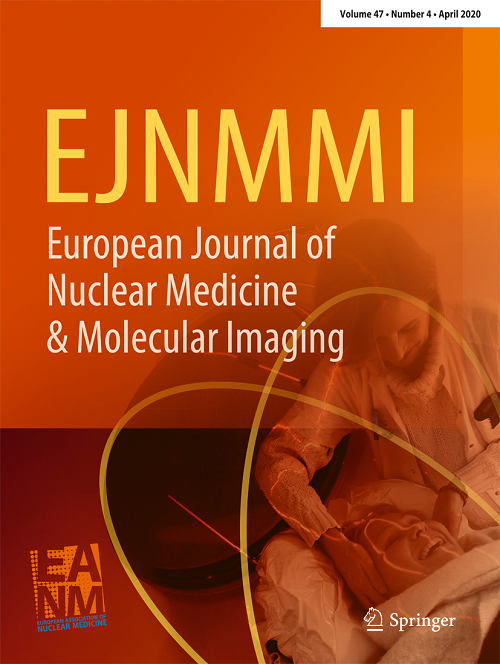PET球探:一项儿科18F-FDG PET/CT成像的宝贵技术。
IF 7.6
1区 医学
Q1 RADIOLOGY, NUCLEAR MEDICINE & MEDICAL IMAGING
European Journal of Nuclear Medicine and Molecular Imaging
Pub Date : 2025-10-16
DOI:10.1007/s00259-025-07554-y
引用次数: 0
摘要
目的探讨PET Scout技术在优化小儿¹⁸F-FDG PET/CT检查流程中的潜在价值。方法将527例行PET/CT显像的患儿前瞻性分为标准剂量组(3.7 MBq/kg, n = 391)和低剂量组(2.5 MBq/kg, n = 136)。在PET/CT扫描前进行全身PET Scout扫描(10 s/床)。Scout MIP图像的视觉分析确定了不正确的定位,放射性污染和正常范围(颅底至大腿中部)以外的病变为异常发现。比较两组的异常检出率和病变检出率。结果在9.7%(51/527)的患者中,pet Scout检测出异常,包括范围外病变(27例)、污染(19例)和姿势异常(5例)。标准剂量组与低剂量组的异常检出率(9.2% vs. 11.0%, χ²= 0.383,P = 0.536)、病变检测效能的ROC曲线下面积(AUC) (0.9086 vs. 0.9104; Z = -0.0953, P = 0.924)差异无统计学意义。标准组和低剂量组的最佳SUVmax截止值分别为3.05(敏感性82.9%,特异性85.4%)和3.25(敏感性81.6%,特异性87.0%)。结论pet Scout能够早期发现异常并实时优化工作流程。该技术在低剂量和标准剂量成像下的病灶检测能力相当,并支持不同剂量策略下的灵活应用。本文章由计算机程序翻译,如有差异,请以英文原文为准。
PET scout: A valuable technology in pediatric 18F-FDG PET/CT imaging.
PURPOSE
To explore the potential value of PET Scout technology for optimizing the examination workflow of pediatric ¹⁸F-FDG PET/CT.
METHODS
A total of 527 children who underwent PET/CT imaging were prospectively divided into a standard-dose group (3.7 MBq/kg, n = 391) and a low-dose group (2.5 MBq/kg, n = 136). A body PET Scout scan (10 s/bed) was performed before PET/CT scan. Visual analysis of Scout MIP images identified improper positioning, radioactive contamination, and lesions outside the normal range (skull base to mid-thigh) as abnormal findings. Abnormal detection rates and lesion detection performance were compared between the two groups.
RESULTS
PET Scout identified abnormal detections in 9.7% (51/527) of patients, including out-of-range lesions (27 cases), contamination (19 cases), and postural abnormalities (5 cases). There was no significant difference in the abnormal detection rate (9.2% vs. 11.0%, χ² = 0.383, P = 0.536) and in the area under the ROC curve (AUC) of lesion detection performance (0.9086 vs. 0.9104; Z = -0.0953, P = 0.924) between the standard-dose group and the low-dose group. Optimal SUVmax cut-offs were 3.05 (sensitivity 82.9%; specificity 85.4%) and 3.25 (sensitivity 81.6%; specificity 87.0%) for the standard and low-dose groups, respectively.
CONCLUSION
PET Scout enables early detection of abnormalities and real-time workflow optimization. The technology is comparable in lesion detectability at low-dose and standard-dose imaging, and supports flexible application under different dose strategies.
求助全文
通过发布文献求助,成功后即可免费获取论文全文。
去求助
来源期刊
CiteScore
15.60
自引率
9.90%
发文量
392
审稿时长
3 months
期刊介绍:
The European Journal of Nuclear Medicine and Molecular Imaging serves as a platform for the exchange of clinical and scientific information within nuclear medicine and related professions. It welcomes international submissions from professionals involved in the functional, metabolic, and molecular investigation of diseases. The journal's coverage spans physics, dosimetry, radiation biology, radiochemistry, and pharmacy, providing high-quality peer review by experts in the field. Known for highly cited and downloaded articles, it ensures global visibility for research work and is part of the EJNMMI journal family.

 求助内容:
求助内容: 应助结果提醒方式:
应助结果提醒方式:


